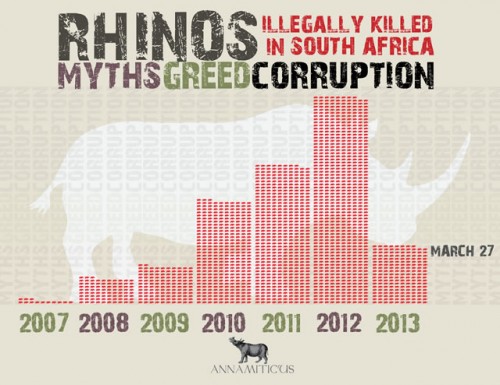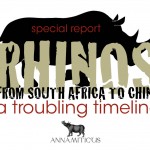
At least 188 rhinos were killed in South Africa during the first quarter of 2013, according to the country’s Department of Environmental Affairs.
Of the 188 rhinos, 135 were killed in Kruger National Park, 17 in North West, 16 in KwaZulu-Natal, ten in Limpopo, and ten in Mpumalanga provinces. 63 suspects have been arrested in South Africa since the beginning of 2013 for rhino crimes, although none are at the “kingpin” level.
South Africa is not the only African country whose rhinos are targeted; Kenya has also been plagued by the rhino crisis. And in Asia, 17 of India’s greater one-horned rhinos (population: 3,300) have been killed for their horns since the beginning of 2013.
In 2012, South Africa’s rhino death toll had reached 135 by March 19th (78 days), 159 by April 4th (94 days), and 199 by April 30th (120 days).
During the CITES CoP16 meeting in Bangkok in March 2013, the South African delegation attempted to gain support for a legal rhino horn trade. However, Allan Thornton of the Environmental Investigation Agency (EIA) pointed out at a press conference that in fact, South Africa is exacerbating the rhino crisis.
The genesis of the demand in Vietnam seems to us to have started in South Africa, with efforts to stimulate that demand. The opportunities for the syndicates arose, it seems to us, from the breakdown of controls in the trophy hunting industry, where the industry of sport hunters, as they call themselves, did not self-regulate. And government oversight was insufficient to prevent the widespread massive abuses that occurred.
Thornton further noted to the delegation that, “Having this discussion, which you say is not about legalizing rhino horn trade, sounds a little bit like Iran saying ‘we’re not building a nuclear bomb’ because it is evident to me that this will clearly stimulate more demand.”
(EIA is spot on. This “discussion”, if you will, has already stimulated demand. Back in December 2010, I wrote about the problem of unscrupulous South African game industry insiders “growing the market, hoping to cash in on the rhino horn myth” in Are ‘Insiders’ Intentionally Fueling Demand for Rhino Horn?)
Although there is no doubt that the demand for rhino horn is mainly from Vietnam and China, the repeated involvement of South Africa’s game industry insiders continues to evade public scrutiny.
See also:
- South Africa’s Rhino Horn Dealers [Podcast]
- Report: Rhino Killings Driven by Private Stockpiling and Trade Speculation
- ‘Legal’ Trade in Rhino Horn is an Old Agenda, Not a New Solution
Source: environment.gov.za



